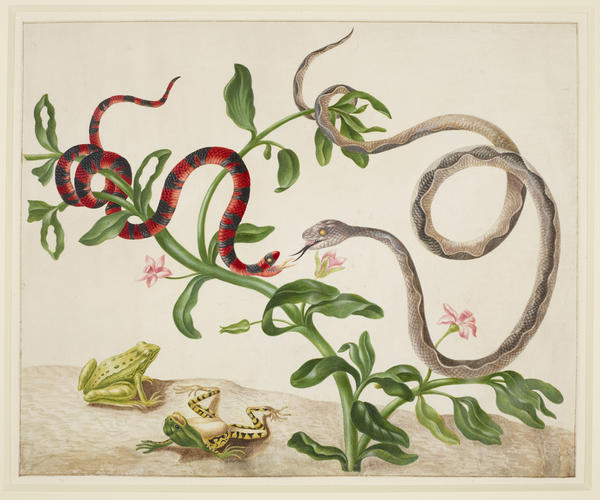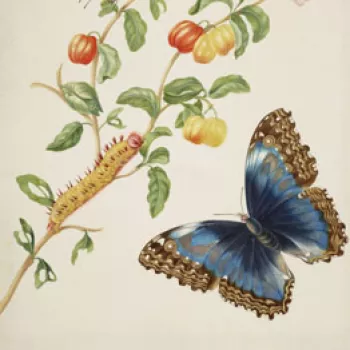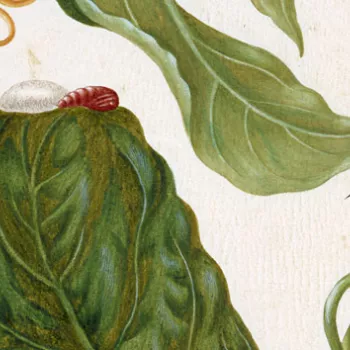False Coral Snake, Banded Cat-Eyed Snake and frogs c. 1705?
Watercolour and bodycolour with gum arabic on vellum | 30.7 x 37.5 cm (whole object) | RCIN 921226
-
A watercolour of a False Coral Snake (Anilius scytale) and a Banded Cat-Eyed Snake (Leptodeira annulata) with two unidentified frogs. As well as bringing back from Suriname many of the insect species which she included in the Metamorphosis, Merian also shipped home a large number of snakes preserved in brandy. Although their dramatic poses are fanciful, the markings of the snakes and the slight sheen on their bodies are recorded here in minute detail. This drawing is one of the ninety-five works acquired by George III as by Maria Sibylla Merian, but is more likely to be by one of her daughters, Johanna or Dorothea, both of whom were talented artists.
Maria Sibylla Merian was the daughter of the printmaker Matthias Merian, and the step-daughter of the still-life painter Jacob Marrel. She was a talented artist, who was trained in flower painting by Marrel. From an early age, she was fascinated by insects and their life cycles, and undertook research into the phenomenon of metamorphosis, which was then only partially understood. She published her findings in a series of books, illustrated with beautifully-composed plates in which each insect life-cycle was illustrated on the appropriate food plant. In 1699, having encountered exotic insects in the cabinets of natural history collectors in Amsterdam, Merian and her younger daughter Dorothea set sail for Suriname, in South America, which was then a Dutch colony. There, they studied the life cycles of Surinamese insects until their return to Europe in 1701. Merian published her Surinamese research as the Metamorphosis Insectorum Surinamensium (The Metamorphosis of the Insects of Suriname) in 1705. The book was very well-received, and by her death Merian was well-regarded throughout Europe as both an entomologist and an artist.Provenance
Dr Richard Mead (1673–1754); his sale (London, Abraham Langford, 13–16 January 1755, lot 66), where purchased by an unknown collector; sold 15 June 1768 (London, Paterson and Eve, lot 572), where purchased by Sir John Hill via Wilson; George III by c.1810
-
Creator(s)
Acquirer(s)
-
Medium and techniques
Watercolour and bodycolour with gum arabic on vellum
Measurements
30.7 x 37.5 cm (whole object)
Other number(s)
RL 21226Alternative title(s)
Unused design for the Metamorphosis Insectorum Surinamensium










